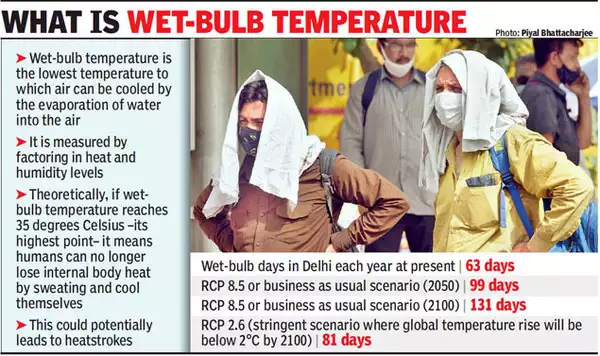Biodiversity & Environment
Wet Bulb Temperature
- 03 Mar 2022
- 5 min read
For Prelims: Wet bulb temperature, Dry bulb temperature, Dew point temperature, Intergovernmental Panel on Climate Change, water vapour, Rising Sea level.
For Mains: Environmental Pollution & Degradation, Conservation, Wet bulb temperature, Impact of rising wet bulb temperature.
Why in News?
Recently, part 2 of the sixth assessment report of Intergovernmental Panel on Climate Change (IPCC), emphasised on the trend in the ‘Wet Bulb’ Temperature in South Asia.
- The trend will provide an index of the impact of heat and humidity combined — and its effect on health.
What is the Wet Bulb Temperature?
- Wet bulb temperature is the lowest temperature to which air can be cooled by the evaporation of water into the air at a constant pressure.
- WBT is a limit that considers heat and humidity beyond which humans can not tolerate high temperatures.
- The Wet Bulb temperature is the temperature of adiabatic saturation. This is the temperature indicated by a moistened thermometer bulb exposed to the air flow.
- An adiabatic process is one in which no heat is gained or lost by the system.
- Wet Bulb temperature can be measured by using a thermometer with the bulb wrapped in wet muslin.
- The adiabatic evaporation of water from the thermometer and the cooling effect is indicated by a "wet bulb temperature" lower than the "dry bulb temperature" in the air.
- The rate of evaporation from the wet bandage on the bulb, and the temperature difference between the dry bulb and wet bulb, depends on the humidity of the air.
- The evaporation is reduced when the air contains more water vapour.
- The wet bulb temperature is always lower than the dry bulb temperature but will be identical with 100% relative humidity (the air is at the saturation line).
- A wet-bulb temperature of 31°C is exceedingly harmful to humans, while a temperature of 35°C is unsurvivable for more than 6 hours.
What are Dew Point and Dry Bulb Temperatures?
- Dry Bulb Temperature:
- The Dry Bulb temperature, usually referred to as "air temperature", is the air property that is most commonly used. When people refer to the temperature of the air they are normally referring to the dry bulb temperature.
- The Dry Bulb Temperature refers basically to the ambient air temperature. It is called "Dry Bulb" because the air temperature is indicated by a thermometer not affected by the moisture of the air.
- Dry-bulb temperature can be measured using a normal thermometer freely exposed to the air but shielded from radiation and moisture.
- The dry-bulb temperature is an indicator of heat content.
- Dew Point Temperature:
- The Dew Point is the temperature where water vapour starts to condense out of the air (the temperature at which air becomes completely saturated).
- Above this temperature the moisture stays in the air.
- If the dew-point temperature is close to the dry air temperature - the relative humidity is high.
- If the dew point is well below the dry air temperature - the relative humidity is low.
- The Dew Point temperature is always lower than the Dry Bulb temperature and will be identical with 100% relative humidity (the air is at the saturation line).
- The Dew Point is the temperature where water vapour starts to condense out of the air (the temperature at which air becomes completely saturated).
How will this Trend Impact India?
- Lucknow and Patna, were among the cities predicted to reach wet-bulb temperatures of 35°C if emissions continued to rise, while Bhubaneswar, Chennai, Mumbai, Indore, and Ahmedabad are ‘at risk’ of reaching wet-bulb temperatures of 32°C-34°C with continued emissions.
- With continuing emissions, parts of central India including Vidarbha are at risk of exceeding wet bulb temperatures of 32-34°C.
- This will have consequences such as a rise in heat-wave linked deaths or reduced productivity.
- Relying on artificial cooling to cope with the growing heat would supercharge energy demand and leave many people dangerously exposed to power failures.
- It would also abandon the most vulnerable members of society and doesn’t help those who have to venture outside.


.png)



